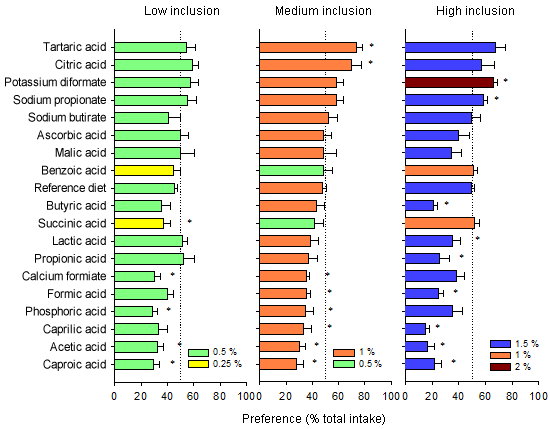The use of acids in pig production has merited a lot of research and an even higher amount of literature around it. Often publications regarding the mode of action of acids have overemphasized the relevance of “in vitro” tests such as the antimicrobial activity or the effect on the acid binding capacity of feeds. In addition, acids in young animals have been claimed to decrease gastric pH and hence improve enzymatic digestion of feeds. However, in general the data reported on the effect of acids on feed digestibility is scarce and lacks consistency. On the other hand the potential impact of acids on palatability and feed intake has been overlooked to a great extent. The objective of this report is to summarize what is known today regarding sour taste perception in pigs.
Many people involved in “hands on” pork production will agree that sour taste is of particular relevance in pigs. This is not surprising when we realize that a lot of natural food sources potentially available to pigs in the wild are rich in organic acids. For example, short chain acids are widely found in a variety of fruits like citrus, wild berries, apples and watermelon but also avocados, broccoli, carrots, mushrooms, potatoes and tomatoes (Table 1). Citric acid is the most common of the acids found in fruits, tubers and vegetables followed by malic and tartaric. Among other commercially available acids, small amounts of fumaric, acetic, and formic are also found in foods naturally available in the wild.

Table 1. Main organic acids present in fruits and vegetables (1)
| Citric | Apple, Apricot, Bananas, Bilberry, Blueberries, Boysenberries, Cherries, Cranberries, Currants, Elderberries, Figs, Gooseberries, Grapefruit, Grapes, Kiwifruit, Kumquat, Lemons, Limes, Loganberry, Orange Peel, Orange, Peaches, Pears, Pineapples, Raspberry, Strawberries, Tangerine, Youngberries, Beans, Broccoli, Carrots, Potatoes, Tomatoes, Rhubarb. |
| Malic | Apples, Apricots, Bananas, Blackberries, Blueberries, Boysenberries, Cherries, Cranberries, Currants, Elderberries, Figs, Gooseberries, Grapefruit, Grapes, Lemons, Limes, Loganberry, Nectarine, Orange peel, Orange, Passion fruit, Peaches, Pears, Pineapples, Plums, Rosehip, Quinces, Salad, Strawberries, Youngberries, Beans, Broccoli, Carrots, Peas, Potatoes, Rhubarb, Tomatoes. |
| Tartaric | Avocados, Bananas, Cherries, Currants, Grapefruit, Grapes, Lemons, Limes, Pears, Plums. |
| Fumaric | Apples, Bean, Carrots, Mushrooms, Tomatoes. |
| Succinic | Apples, Blueberries, Cherries, Currants, Strawberries, Beans, Carrots, Tomatoes. |
| Acetic | Bananas (traces). |
| Formic | Bananas (traces). |
| Lactic | Apples. |
(1) Fruits and vegetables with significant quantities of the acid are shown in bold and italics. The relative amount of acids in each fruit or vegetable vary widely with the variety, degree of ripeness and seasonal changes of the harvest.
Organic acids have two sensory components that may affect appetence: somatosensing and taste. Somatosensing in the oral cavity is perceived through the trigeminal nerve. Seemingly, the transmembrane ion channel TRPA1 is responsible for perception of pungency as part of the pain pathway (referred to as a nociceptor). Several acids stimulate TRPA1. Weak acids such as Acetic, Propionic, Formic and Lactic are only partially dissociated at neutral pH and may cross the cell membrane acidifying the neuronal cytosol and stimulate the nociceptor leading to pungency and pain. However, strong acids such as Citric and Tartaric, were inert at a trigeminal level resulting in no or insignificant pungency responses (Wang et al., 2011). Thus, weak acids (e.g. Acetic, Propionic, Formic and Lactic) are likely to result in aversive responses in pig.
Sour taste is known for acid perception and is sensed mainly through tongue’s taste buds that connect taste agonists to the gustatory cortex via taste sensory cells and the cranial nerves VII (Chorda Tympany), IX (Glossofaryngeal) and X (Vagus). Protein complexes PKD1L3 and PKD2L1 have been proposed as responsible for sourness perception. However, there is only a moderate correlation between the hydrogen ion concentration of a food and its perceived sourness due to the penetration of non-dissociated acids inside the taste cells. Electrophysiological studies in pigs performed by Danilova et al. (1999) found citric and ascorbic acids to elicit the largest responses in pig taste nerves among a wide group of potential taste agonists but these responses were not linked to any behavioural tests. Recently, Suarez et al. (2010) reviewed in a systematic manner how feed addition of organic acids and some salts affects preferences (Figure 1). The results showed that, at 1% inclusion level, Citric and Tartaric acids significantly improved feed preferences while Caproic, Caprilic, Acetic, Phosphoric and Formic resulted in an aversive response. In contrast, the potassium salt of Formic acid did not show any sign of aversion. In trials performed under more practical conditions Formic acid and combinations of Formic and Propionic acids have consistently been reported to decrease feed intake. The fact that a good part of the market has shifted to the use of the salts of organic acids, may be a reflection, in part, of the effect of weak acids on pungency and ultimately feed intake.
In conclusion, Citric and Tartaric acids trigger an innate sour taste that is attractive to pigs while their pungency is smooth and remains unnoticed. Their use in feeds is recommended. On the opposite side, weak acids such as Acetic, Formic or Propionic trigger the somatic pain pathway and result in aversive responses to feed. Unless presented in the form of some salts or coated, the use of such acids should be avoided in piglet feeds due to palatability issues.
Figure 1. Dietary preferences of acids en salts in piglets. (Reproduced with permission of the authors: Suarez et al., J. Anim. Sci. Vol. 88, E-Suppl. 2: 651, 2010).

*The asterisks indicate that the means are significantly (P<0.05) different than the neutral value of 50 %.




